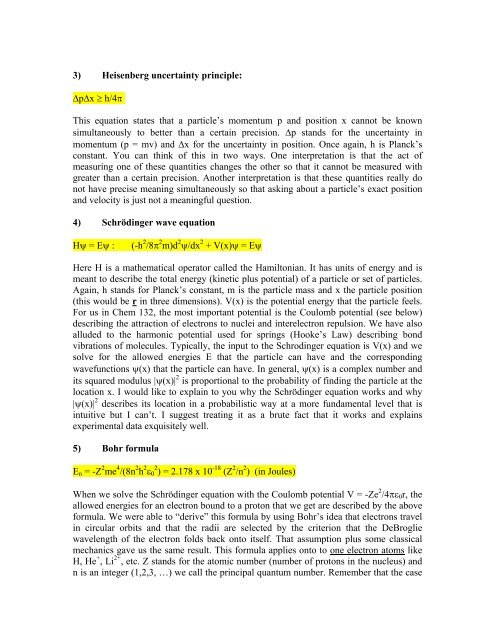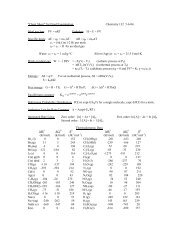Equations we use in Chem 132 - Chemistry
Equations we use in Chem 132 - Chemistry
Equations we use in Chem 132 - Chemistry
Create successful ePaper yourself
Turn your PDF publications into a flip-book with our unique Google optimized e-Paper software.
3) Heisenberg uncerta<strong>in</strong>ty pr<strong>in</strong>ciple:∆p∆x ≥ h/4πThis equation states that a particle’s momentum p and position x cannot be knownsimultaneously to better than a certa<strong>in</strong> precision. ∆p stands for the uncerta<strong>in</strong>ty <strong>in</strong>momentum (p = mv) and ∆x for the uncerta<strong>in</strong>ty <strong>in</strong> position. Once aga<strong>in</strong>, h is Planck’sconstant. You can th<strong>in</strong>k of this <strong>in</strong> two ways. One <strong>in</strong>terpretation is that the act ofmeasur<strong>in</strong>g one of these quantities changes the other so that it cannot be measured withgreater than a certa<strong>in</strong> precision. Another <strong>in</strong>terpretation is that these quantities really donot have precise mean<strong>in</strong>g simultaneously so that ask<strong>in</strong>g about a particle’s exact positionand velocity is just not a mean<strong>in</strong>gful question.4) Schröd<strong>in</strong>ger wave equationHψ = Eψ :(-h 2 /8π 2 m)d 2 ψ/dx 2 + V(x)ψ = EψHere H is a mathematical operator called the Hamiltonian. It has units of energy and ismeant to describe the total energy (k<strong>in</strong>etic plus potential) of a particle or set of particles.Aga<strong>in</strong>, h stands for Planck’s constant, m is the particle mass and x the particle position(this would be r <strong>in</strong> three dimensions). V(x) is the potential energy that the particle feels.For us <strong>in</strong> <strong>Chem</strong> <strong>132</strong>, the most important potential is the Coulomb potential (see below)describ<strong>in</strong>g the attraction of electrons to nuclei and <strong>in</strong>terelectron repulsion. We have alsoalluded to the harmonic potential <strong>use</strong>d for spr<strong>in</strong>gs (Hooke’s Law) describ<strong>in</strong>g bondvibrations of molecules. Typically, the <strong>in</strong>put to the Schrod<strong>in</strong>ger equation is V(x) and <strong>we</strong>solve for the allo<strong>we</strong>d energies E that the particle can have and the correspond<strong>in</strong>gwavefunctions ψ(x) that the particle can have. In general, ψ(x) is a complex number andits squared modulus |ψ(x)| 2 is proportional to the probability of f<strong>in</strong>d<strong>in</strong>g the particle at thelocation x. I would like to expla<strong>in</strong> to you why the Schröd<strong>in</strong>ger equation works and why|ψ(x)| 2 describes its location <strong>in</strong> a probabilistic way at a more fundamental level that is<strong>in</strong>tuitive but I can’t. I suggest treat<strong>in</strong>g it as a brute fact that it works and expla<strong>in</strong>sexperimental data exquisitely <strong>we</strong>ll.5) Bohr formulaE n = -Z 2 me 4 /(8n 2 h 2 ε 0 2 ) = 2.178 x 10 -18 (Z 2 /n 2 ) (<strong>in</strong> Joules)When <strong>we</strong> solve the Schröd<strong>in</strong>ger equation with the Coulomb potential V = -Ze 2 /4πε 0 r, theallo<strong>we</strong>d energies for an electron bound to a proton that <strong>we</strong> get are described by the aboveformula. We <strong>we</strong>re able to “derive” this formula by us<strong>in</strong>g Bohr’s idea that electrons travel<strong>in</strong> circular orbits and that the radii are selected by the criterion that the DeBrogliewavelength of the electron folds back onto itself. That assumption plus some classicalmechanics gave us the same result. This formula applies onto to one electron atoms likeH, He + , Li 2+ , etc. Z stands for the atomic number (number of protons <strong>in</strong> the nucleus) andn is an <strong>in</strong>teger (1,2,3, …) <strong>we</strong> call the pr<strong>in</strong>cipal quantum number. Remember that the case



